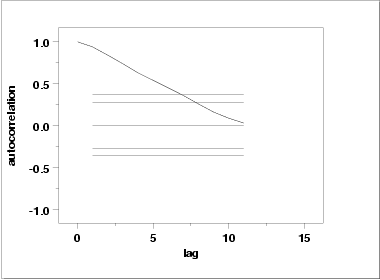1.4. EDA Case Studies
1.4.2. Case Studies
1.4.2.6. Filter Transmittance
1.4.2.6.3. |
Quantitative Output and Interpretation |
Sample size = 50
Mean = 2.0019
Median = 2.0018
Minimum = 2.0013
Maximum = 2.0027
Range = 0.0014
Stan. Dev. = 0.0004
Coefficient Estimate Stan. Error t-Value
B0 2.00138 0.9695E-04 0.2064E+05
B1 0.185E-04 0.3309E-05 5.582
Residual Standard Deviation = 0.3376404E-03
Residual Degrees of Freedom = 48
The slope parameter, B1, has a
t value of 5.582,
which is statistically significant. Although the estimated slope,
0.185E-04, is nearly zero, the range of data (2.0013 to 2.0027) is
also very small. In this case, we conclude that there is drift
in location, although it is relatively small.
H0: σ12 = σ22 = σ32 = σ42
Ha: At least one σi2 is not equal to the others.
Test statistic: W = 0.971
Degrees of freedom: k - 1 = 3
Significance level: α = 0.05
Critical value: Fα,k-1,N-k = 2.806
Critical region: Reject H0 if W > 2.806
In this case, since the Levene test statistic value of 0.971 is
less than the critical value of 2.806 at the 5 % level, we conclude that
there is no evidence of a change in variation.
One check is an autocorrelation plot that shows the autocorrelations for various lags. Confidence bands can be plotted at the 95 % and 99 % confidence levels. Points outside this band indicate statistically significant values (lag 0 is always 1).

The lag 1 autocorrelation, which is generally the one of most interest, is 0.93. The critical values at the 5 % level are -0.277 and 0.277. This indicates that the lag 1 autocorrelation is statistically significant, so there is strong evidence of non-randomness.
A common test for randomness is the runs test.
H0: the sequence was produced in a random manner
Ha: the sequence was not produced in a random manner
Test statistic: Z = -5.3246
Significance level: α = 0.05
Critical value: Z1-α/2 = 1.96
Critical region: Reject H0 if |Z| > 1.96
Because the test statistic is outside of the critical region, we
reject the null hypothesis and conclude that the data are not random.
Analysis for filter transmittance data
1: Sample Size = 50
2: Location
Mean = 2.001857
Standard Deviation of Mean = 0.00006
95% Confidence Interval for Mean = (2.001735,2.001979)
Drift with respect to location? = NO
3: Variation
Standard Deviation = 0.00043
95% Confidence Interval for SD = (0.000359,0.000535)
Change in variation?
(based on Levene's test on quarters
of the data) = NO
4: Distribution
Distributional tests omitted due to
non-randomness of the data
5: Randomness
Lag One Autocorrelation = 0.937998
Data are Random?
(as measured by autocorrelation) = NO
6: Statistical Control
(i.e., no drift in location or scale,
data are random, distribution is
fixed, here we are testing only for
normal)
Data Set is in Statistical Control? = NO
7: Outliers?
(Grubbs' test omitted) = NO

